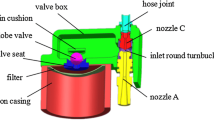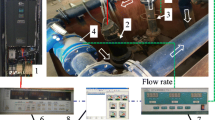Abstract
Sewage self-priming pumps are widely used in municipal sewage treatment and agricultural irrigation. The impeller is the key component to determine the hydraulic performance of sewage self-priming pump. In this study, the ZW100-100-15 sewage self-priming pump was selected as a research object. Five double-channel impellers with different blade profiles were designed based on the same meridional shape. The ANSYS CFX 16.2 and shear stress transport k–ω turbulence model were conducted to investigate the sewage pump models with five different impellers numerically. The entropy production theory was applied to analyze the internal energy losses of different sewage pump models. The mechanism of influence of blade profiles on the energy losses was investigated systematically. The results indicated that under different flow rate conditions, the hydraulic efficiency of S5 scheme with a concave blade angle distribution profile is higher than that of other schemes. At the design flow rate, the head of S5 was the highest, the flow state inside the impeller was the most stable and the energy loss inside the impeller was the least. In non-design conditions, the flow distribution and entropy production rate distribution of S5 were significantly better than those of other schemes. Results illustrated that flow separation, backflow, shock effect, vortex and rotor–stator interaction were the main inducers for the formation of entropy production. This research indicated that the entropy production theory can predict the irreversible energy loss in pump accurately and the blade profile optimization can effectively improve the sewage self-priming pump hydraulic performance and weaken the unstable flow and its internal energy loss.
















Similar content being viewed by others
References
Huang Y, Liu Y, Xu MZ, Zhao LQ (2016) Experience and revelation from five water body administrative management mechanism in Zhejiang Province. Environ Sci Manag 41(4):12–15 (In Chinese)
Tan LW, Zhang DS, Shi WD, Zhou L, Cai XT (2017) Influence of volute basic circle diameter on the pressure fluctuations and flow noise of a low specific speed sewage pump. J Vibroeng 19(5):3779–3796
Tao Y, Yuan SQ, Liu JR, Zhang F, Yuan JP (2016) Influence of blade thickness on transient flow characteristics of centrifugal slurry pump with semi-open impeller. Chin J Mech Eng 29(6):1209–1217
Ding HC, Li ZK, Gong XB, Li MS (2019) The influence of blade outlet angle on the performance of centrifugal pump with high specific speed. Vacuum 159:239–246
Yousefi H, Noorollahi Y, Tahani M, Fahimi R, Saremian S (2019) Numerical simulation for obtaining optimal impeller’s blade parameters of a centrifugal pump for high-viscosity fluid pumping. Sustain Energy Technol Assess 34:16–26
Wang T, Kong FY, Xia B, Bai YX, Wang C (2017) The method for determining blade inlet angle of special impeller using in turbine mode of centrifugal pump as turbine. Renew Energy 109:518–528
Cui BL, Wang CF, Zhu ZC, Jin YZ (2013) Influence of blade outlet angle on performance of low-specific-speed centrifugal pump. J Therm Sci 22(2):117–122
Bai YX, Kong FY, Yang SS, Chen K, Dai T (2017) Effect of blade wrap angle in hydraulic turbine with forward-curved blades. Int J Hydrog Energy 42(29):18709–18717
Tan L, Zhu BS, Cao SL, Bing H, Wang YM (2014) Influence of blade wrap angle on centrifugal pump performance by numerical and experimental study. Chin J Mech Eng 27(1):171–177
Alexeev RA, Tishchenko VA, Gribin VG, Gavrilov IY (2017) Turbine blade profile design method based on Bezier curves. J Phys Conf Ser 891(1):1–6
Kruyt NP, Westra RW (2014) On the inverse problem of blade design for centrifugal pumps and fans. Inverse Probl 30(6):1–22
Wu DH, Ren Y, Mou JG, Gu YQ, Jiang LF (2019) Unsteady flow and structural behaviors of centrifugal pump under cavitation conditions. Chin J Mech Eng 32(1):1–15
Bastos HMC, Torres PJG, Álvarez CEC (2018) Numerical simulation and experimental validation of a solar-assisted heat pump system for heating residential water. Int J Refrig 86:28–39
Zhou L, Bai L, Li W, Shi WD, Wang C (2018) PIV validation of different turbulence models used for numerical simulation of a centrifugal pump diffuser. Eng Comput 35(1):2–17
Yang J, Pavesi G, Liu XH, Xie T, Liu J (2018) Unsteady flow characteristics regarding hump instability in the first stage of a multistage pump-turbine in pump mode. Renew Energy 127:377–385
Li DY, Wang HJ, Qin YL, Han L, Wei XZ, Qin DQ (2017) Entropy production analysis of hysteresis characteristic of a pump-turbine model. Energy Convers Manag 149:175–191
Li XJ, Zhu ZC, Li Y, Chen XP (2016) Experimental and numerical investigations of head-flow curve instability of a single-stage centrifugal pump with volute casing. Proc Inst Mech Eng Part A J Power Energy 230(7):633–647
Hou HC, Zhang YX, Li ZL, Jiang T, Zhang JY, Xu C (2016) Numerical analysis of entropy production on a LNG cryogenic submerged pump. J Nat Gas Sci Eng Part A 36:87–96
Blaise M, Feidt M, Maillet D (2018) Influence of the working fluid properties on optimized power of an irreversible finite dimensions Carnot engine. Energy Convers Manag 163:444–456
Hagerstrom AM, Murphy TE, Roy R (2015) Harvesting entropy and quantifying the transition from noise to chaos in a photon-counting feedback loop. Proc Natl Acad Sci USA 112(30):9258–9263
Prasad RK, Sahu MK (2017) Entropy generation and thermodynamic analysis of solar air heaters with artificial roughness on absorber plate. Arch Thermodyn 38(3):23–48
Gorla RSR, Gireesha BJ (2015) Transient velocity and steady state entropy generation in a microfluidic Couette flow containing charged nano particles. Int J Appl Mech Eng 20(4):787–804
Ren Y, Zhu ZC, Wu DH, Li XJ (2019) Influence of guide ring on energy loss in a multistage centrifugal pump. J Fluids Eng 141(6):061302
Bejan A (1996) Entropy generation minimization: the new thermodynamics of finite-size devices and finite-time processes. J Appl Phys 79(3):1191–1218
Kock F, Herwig H (2004) Local entropy production in turbulent shear flows: a high-Reynolds number model with wall functions. Int J Heat Mass Transf 47(10):2205–2215
Acknowledgements
The authors gratefully acknowledge the support from the National Natural Science Foundation of China (No. 51606167 and 51609212), the Open Foundation of Zhejiang Provincial Top Key Academic Discipline of Mechanical Engineering (No. ZSTUME02A04) and Postdoctoral Research Foundation of Zhejiang Province (CN) titled with “Studies on the inner flow mechanism in the centrifugal pump impeller at lower flow rate conditions based on anisotropic LES analysis.”
Author information
Authors and Affiliations
Corresponding author
Additional information
Technical Editor: Jader Barbosa Jr., PhD.
Publisher's Note
Springer Nature remains neutral with regard to jurisdictional claims in published maps and institutional affiliations.
Rights and permissions
About this article
Cite this article
Wu, D., Zhu, Z., Ren, Y. et al. Influence of blade profile on energy loss of sewage self-priming pump. J Braz. Soc. Mech. Sci. Eng. 41, 470 (2019). https://doi.org/10.1007/s40430-019-1978-2
Received:
Accepted:
Published:
DOI: https://doi.org/10.1007/s40430-019-1978-2




